Many times, I find myself working with talented flutists on a short term basis, either as a substitute teacher, a clinician, a body mapping teacher, or during lessons at a summer workshop. One of the first things I ask is, “Do you have any pain when you play?” It is depressingly common for flutists tell me they have pain in their right hand. Sometimes, it’s on the pinky side up onto the forearm. Other times, it’s the thumb side. Sometimes it’s in the fingers, other times it’s more concentrated around the wrist. Based on their answers to my questions, I usually have a pretty good guess what I’m going to see when they play for me – a locked pinky finger and a ‘clamp’ between the right thumb and pinky. In full disclosure – the problem that brought me into the world of body mapping was a right hand pinky issue. There are many things contributing to this overall pattern and this article is the first in a series addressing these issues individually. Below are two photos attempting to show what I’m talking about.
DISCLAIMER #1 – I am not a physician, but I am a licensed massage therapist and Neurokinetic Therapy practitioner. However, I cannot diagnose. If you have severe pain, you must be evaluated by a medical professional.
DISCLAIMER #2 – Every flute teacher in the world has a preferred way of explaining how we hold the flute. At the most basic level, there are two fundamentally different methods. I call them the “pushing” camp and the “holding up from underneath” camp. With the “pushers”, the left hand index finger pushes the tube in towards the flutist’s face and the right hand thumb pushes the flute away. For the “holders uppers”, the base of the left hand index finger and the right thumb are holding the flute up from underneath – no pushing in or out. Flute teachers can debate the merits of each method – there are many successful flutists and teachers in each camp. The purpose of this article isn’t to debate these two methods, as the issue that I’m describing with right hand position is common with both.
THE PROBLEM
This problem is caused by a lack of understanding about how the forearm and hand work together.
1) Forearm rotation
There are two bones in the forearm, the ulna (on the pinky side) and the radius (on the thumb side). When the palm is up (supination) the ulna and radius are roughly parallel to each other. When the palm is oriented down towards the floor (pronation) the ulna is crossing over the radius. [insert image forearm rotation]
This whole movement is called forearm rotation and it happens at the elbow, not the wrist. Yes, the wrist is moving, but it’s a result of the forearm movement. Many people think that pronation and supination of the hand happens at the wrist. Many of the same people also have hand and wrist pain. If you place you left hand index finger on the bony thing we call the “elbow”, that’s actually the end of the ulna. If you pronate and supinate (palm up to palm down and repeat), you’ll feel that the ulna is not moving. Put your right arm down flat on a table or desk with the palm up. Move into palm down and notice that the thumb side comes over the pinky side. Try going the other way — pinky side moving over the thumb side. Can’t do it…. that’s not how the forearm is designed.
2) Neutral hand to forearm relationship
The hand should be lined up (more or less) with the pinky side of the hand, not the thumb. Let your arms hang down at your sides and then bend your elbows and bring your hands up to piano playing position and FREEZE. Are your hands lined up on thumb side or pinky side? Almost all of the flutists I described in the first paragraph are habitually lined up along the thumb side. This is the fundamental problem.
We’re going to do this incorrectly on purpose — with your right hand palm down, line up thumb with your forearm. Do you notice your fingers are know forced to point off to the side? This is called ulnar deviation because the fingers are deviating to the ulnar (pinky side). I call this “No” position because it’s thumb oriented.
Bring your hand back into a more neutral relationship by moving so you’re lined up with the pinky side. This is “Yes” position.
Go back and forth between “Yes” and “No” so that you can clearly see and feel the difference. I use these names because it’s very easy for my beginning flute students and college students who are not native English speakers to keep track of which is which because they don’t have to remember what “ulnar deviated” means.
Experiment #1: Go back to the “yes” starting position – palm down, lined up along pinky side and lightly rest your left hand on top of your arms. Wiggle your right hand fingers like you’re doing T&G #4. Notice what you feel, both with your left hand and your right hand fingers. Now, go into “no” position and repeat the wiggling. You should notice two things — 1) there’s a lot more muscular work going on with thumb alignment and 2 )it’s much easier to move quickly and evenly in “yes” position.
Experiment # 2: Start in “Yes” position — palm up, pinky aligned and rotate through to palm down. This is should be easy. Now move into “No” position – palm up and thumb aligned and rotate through to palm down again. You should find that you can do it, but it’s a lot more work and not as smooth. My students say, “…This is weird.” Indeed.
Experiment #3: Hang from a bar, tree branch or just pretend if you don’t have a bar or tree handy. Which way are you lined up? Pinky side — this is the strong side of your hand. Grip strength involves pinky and other fingers. The thumb and first fingers are for dexterity. Watch monkeys hanging in a zoo. Watch babies and toddlers pick up their toys. Look at the pinky grip my daughter (she’s almost 11 now) is demonstrating below.
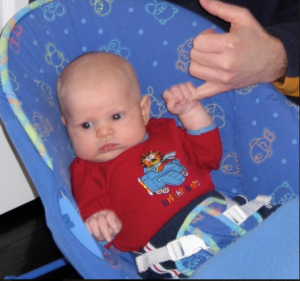
Why is ulnar-deviation “bad?”
First – even though I have used “yes” and “no” in terms of labeling two distinct alignments, no alignment is bad or good. Humans are brilliantly designed to make infinite types of movements. The problem comes when you move away from neutral and then stay there. Many of our tools, like screwdrivers, require that we move into ulnar-deviation to use them effectively. Here are the symptoms that show up when flutists play with a ulnar-deviated right hand position: cold fingers, numb fingers, tingly fingers, pain shooting down into the fingers, pain radiating back up the forearm. The reason is because of what’s happening in the wrist. There are 8 bones, roughly two rows of 4, that make up the wrist. When the palm is up, the surface of these wrist bones is slightly curved with a flap of connective tissue over the top. This is the carpal tunnel — it looks like a actual tunnel. The top is the connective tissue and the curved bit on the bottom is the shape of the carpal bones.
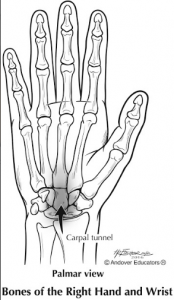
When we go into ulnar-deviation, the relationship between these bones changes. The tunnel changes shape, which can and does impact the 9 tendons (8 for fingers, one for thumb) , the median nerve, and the blood supply going to the hand. Have you ever been on a bus trying to go into Manhattan through the Holland Tunnel during rush hour? It’s hot, it’s crowded and people are cranky. There are too many things for the size of the space. The same thing happens to tendons, nerve, and blood supply when the tunnel shape is made smaller. You get inflammation and pressure. This is why the first thing a doctor does once a patient is diagnosed with carpal tunnel issues is to put the patient into a brace that forces the hand into neutral.
Why are so many flutists thumb-oriented?
The flutists with the right hand pain that I described are consistently thumb oriented, instead of pinky oriented, with the right arm in playing position. Here’s my theory about why this is so – just about always, we put the thumb on the tube first and then put the fingers on, which reinforces thumb-orientation before the first note is played. One solution is to put the pinky finger on first. So stand the flute up on your leg, holding it with the left hand. Put right hand pinky on first, then finger, finger, finger, thumb. I ask collegiate flute majors to do this and they can’t do it at first, so don’t feel bad if this is hard. The desire to get the thumb on first is ridiculously hard to overcome. Use your eyes and watch your hand. Put it on – take it off- repeat a million times to learn a new movement pattern. For those of you who teach beginners, they will always have their right hand fingers on the right keys if they learn “Pinky, finger, finger, finger, thumb.”
For most flutists, when they get their hand on the flute with this method, the contact point with the right thumb is different. That’s ok for now. The next article in this series will talk more about that specific issue. Everybody’s hands are unique and there’s no one “right” position for everyone.
Another clue
Look at the space between the right index finger and the thumb. In a pinky-oriented (“yes”) hand position, there’s a big roundish space here, like a backwards letter “c.” Look at the photo at the end of the article. For a thumb-oriented (“no”) hand position, there is often no space here at all and the index finger may be resting against the rod. There’s an example of this up at the top of the article.
One last puzzle piece
Often, flutists will get their right hand on the flute while maintaining neutral hand to forearm relationship, but the angle between the fingers and the keys is not quite right. Here’s the solution to that problem: without a flute in your hand, pretend you’re turning a door knob 1/4 of a turn to the right. This is an elbow movement, not a wrist movement. This is the slight adjustment that needs to be made to get the fingers ideally situated over the keys. Below are better images to compare and contrast with the first set of photos at the top.
If you have right hand pain like I’ve described, I highly suggest that you begin the journey of learning a more advantageous right hand position. It will take longer than you want and it will be frustrating, but it’s vitally important if you want to have a pain-free, long, illustrious flute career. It’s much easier and takes less time to address the hand/arm position that is causing pain before you end up with tendinitis or carpal tunnel syndrome.
Points that will be covered in future articles include why we clamp in the first place, flute balancing, all things thumb, all things pinky and ways to alter the flute itself to help.

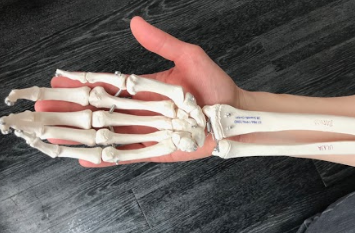
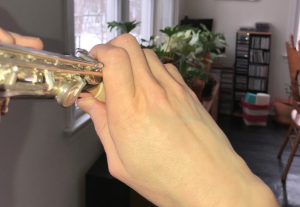
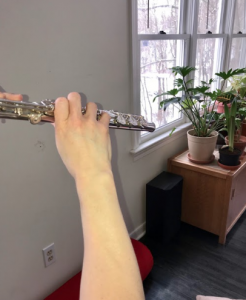

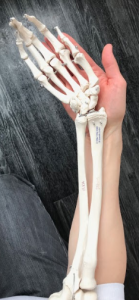
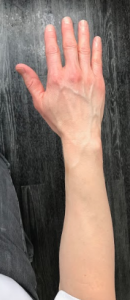


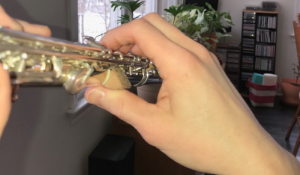
Very interesting! I played piano before I played flute, so I naturally bring my hands up to pinky-level, not thumb. and align with the pinky. However, I remember one day in high school band practice (many years ago, LOL) members of my flute section comparing our right pinkies. We each had a bit of an inward curve in them as compared to the left. We all had been playing for several years, stretching this pinky finger out farther than the other. Now it is the hand that has moved off to the right for years with a computer mouse or the pinky that reaches for the backspace key on a keyboard.
Are there exercises to do. My right thumb (fleshy) part is sore, more so when I play the flute than the picc.
I have read countless articles on right hand position for flute and none of them up until reading yours fully explains the correct position of fingers and thumb. I have excellent teacher who has helped enormously with all of my posture, head, left hand right hand feet and everything. But I still have this niggling discomfort in my right hand. Just slightly awkward for scale passages and complex right hand passages. I think your article has nailed it. I will start immediately with your recommendations and hopefully report back in a few weeks time.
One thing I wanted to check. I read an article mentioning the advice of Susan Milan, international flute player. Her advice to a student who attended a master class was to place the right thumb so that it is positioned parallel to the flute approximately and so the tip of the thumb is pointing towards the head joint. To my thinking, this is the position we end up with if the hand is rotated a quarter turn clockwise – the movement you say comes from the elbow. This is the last tip that you give in your article. Do you agree with my assessment? By doing this, I find my fingers more comfortably aligned to the hand and I think it will be easier to play. By the way I use Thumbport No.1 and find it helpful. But I am going to try this Susan Milan position with the tip of thumb pointing towards flute head, rather than have the thumb coming out at right angles from the flute.
Thanks for your comments, Peter. My suggestion is to try this thumb position and see what happens. Everyone is different. Everything works for somebody AND nothing works for everybody. It depends. Keep in mind that a change in thumb position is part of the the whole hand, whole arm and whole body, rather than just your right thumb all on its own. Good luck!
Thank you so much for this!! Instantly helps your continuity of sound as well as the hand pain!
Brilliant article. Thank you so much – it makes perfect sense! I can’t wait to try this out. Thankyou for taking the time to explain in such easy to understand terms.
You’re welcome! I’m glad the information is helpful to you.
Thank you so much – this has helped me enormously. I have had big problems with internal shoulder rotation & this explains the problem so well. Really appreciate you taking time to share this. kind regards Maureen x
my daughter (11, playing about 2 yrs) is very resistant to practice due to pain in her hands and wrists. Thank you for sharing this, I’m truly hoping it will help ease her discomfort so she can/will practice longer and better!
Great information! I am picking up the flute after a 6 year hiatus. Never had pain before, but after a few weeks of practicing, yesterday I experienced pain in my right thumb, specifically in the joint at the base of the thumb. I am looking forward to assessing my hand position and seeing if I am just not holding the flute the way I used to.
I just restarted playing flute at 75 years old, and have played saxophone and flute in the past. I am jazz lover and wanna be player. My right hand is killing me and am experiencing general weakness actually in both hands but mostly my right hand. I’ll reread this article and try and adapt holding the instrument in the “yes” method. Am travelling now but will try Wednesday when I land